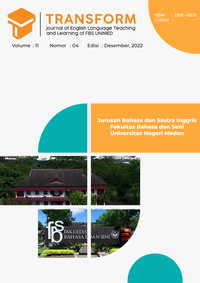A Study of Sarcasm of TV Series Friends
DOI:
https://doi.org/10.24114/tj.v11i4.44037Keywords:
Sarcasm, TV Show, Netflix, FriendsAbstract
The objectives of this study were to find out 1) The types of sarcasm in TV Series Friends, and 2) The purpose of sarcasm in TV Series Friends. The data were analyzed in descriptive qualitative research. The data of this research were from the utterance of Friends™ cast or character. The data were taken from all the words, phrases, clauses, sentences in Friends transcript which available on the internet. The result of this research showed that 1) there were four types of sarcasm are used by Friends™ character, namely: like-prefixed sarcasm with a total number 9 utterances (21.4%), lexical sarcasm with a total number 11 utterances (26.2%), propositional sarcasm with total 16 utterances (38.1%), and illocutionary 6 utterances (14.3%). 2) There were five purposes of sarcasm are used by Friends™ character, namely: sophistication with a total number 19 utterances (45.2%), evaluation with a total number 5 utterances (11.9%), tool for politeness with a total 5 utterances (11.9%), the persuasive aspect with a total number 7 utterances (16.7%), retract ability with a total 1 utterance (2.4%) and group affiliation with a total number 5 utterances (11.9%).Downloads
Published
2023-06-05
Issue
Section
Articles
License
Copyright (c) 2023 Ryo Tauhid Ramadhan, Winda Setiasari

This work is licensed under a Creative Commons Attribution-ShareAlike 4.0 International License.
Authors who publish with this journal agree with the following terms:
- Authors retain copyright and grant the journal right of first publication with the work simultaneously licensed under a Creative Commons Attribution License that allows others to share the work with an acknowledgment of the work's authorship and initial publication in this journal.
- Authors are able to enter into separate, additional contractual arrangements for the non-exclusive distribution of the journal's published version of the work (e.g., post it to an institutional repository or publish it in a book), with an acknowledgment of its initial publication in this journal.
- Authors are permitted and encouraged to post their work online (e.g., in institutional repositories or on their website) prior to and during the submission process, as it can lead to productive exchanges, as well as earlier and greater citation of published work (See The Effect of Open Access).
- This work is licensed under a Creative Commons Attribution-ShareAlike 4.0 International License.

This work is licensed under a Creative Commons Attribution-NonCommercial-ShareAlike 4.0 International License.



